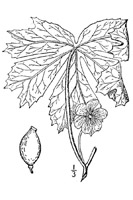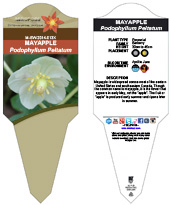Mayapple is a herbaceous perennial plant in the barberry family. The genus podophyllum was created be Carl Linnaeus, a swedish botanist and physician, in 1753. In the past, several species were included in the genus, however except for mayapple, all other species have been transferred to other genera. Mayapple is widespread across most of the eastern United States and southeastern Canada. Though the common name is mayapple, it is the flower that appears in early May, not the "apple". The fruit or "apple" is produced early summer and ripens later in summer. The genus name come from the greek words podos "foot," and phyllon "leaf," a reference to the leaf and how it is attached. The species name peltatum means "shield-like" referring to the leaf shape.
Mayapple contains podophyllin which is used as a purgative and is used in the treatment of plantar warts. Mayapple is also grown as ornamental plants for their attractive foliage and flowers.
Within the realm of rational and holistic medicine, mayapple has been used by American Indians as an emetic, cathartic, and antihelmintic agent. The poisonous roots of the mayapple was also boiled and the spent water was used to cure stomach aches. The rhizome of the mayapple has been used for a variety of medicinal purposes, originally by indigenous inhabitants and later by other settlers. Mayapple can be also used topically for warts, and two of its derivatives, etoposide and teniposide, have shown promise in treating some malignant neoplasms.
Please note that MIROFOSS does not suggest in any way that plants should be used in place of proper medical and psychological care. This information is provided here as a reference only.
Mayapple is considered to be toxic and should not be used as a food source.

Mayapples are woodland plants, typically growing in colonies derived from a single root. Mayapple can grow from 30cm to 45cm tall with palmately lobed umbrella-like leaves up to 20cm to 40cm in diameter with 3 to 9 shallowly to deeply cut lobes. The plants produce several stems from a creeping underground rhizome; some stems bear a single leaf and do not produce any flower or fruit, while flowering stems produce two or more of leaves with 1 to 8 flowers in the axil between the apical leaves. The flowers are white, yellow or red, 2cm to 6cm in diameter with 6 to 9 petals, and mature into a green, yellow or red fleshy fruit 2cm to 5cm long. All the parts of the plant, excepting the fruit, are poisonous. Even the fruit, though not dangerously poisonous, can cause unpleasant indigestion. Mayapple plants depend on mycorrhizae to assist with nutrient uptake in infertile conditions. Mayapple plants are commonly found infected by the rust Allodus podophylli, appearing as honeycomb-patterned orange colonies under the leaves, and yellowish lesions on the upper surface.
| Plant Height |
30cm to 45cm |
| Habitat |
Rich woodlands and damp shady cleanings |
| Leaves |
Palmately lobed into three to nine lobes |
| Leaf Margin |
Lobate |
| Leaf Venation |
Pinnate |
| Stems |
Smooth Stems |
| Flowering Season |
April to June |
| Flower Type |
Radially Symmetrical |
| Flower Colour |
White, Yellow, Red |
| Pollination |
Bees, Insects |
| Flower Gender |
Flowers are hermaphrodite and the plants are self-fertile |
| Fruit |
Hard oval seeds |
| USDA Zone |
4B (-28°C to -31°C) cold weather limit |
The following health hazards should be noted when handling or choosing a location to plant mayapple:
 |
TOXIC
Mayapple plants conatins podophyllotoxin which is considered to be extremely toxic.
|
 |
-Click here- or on the thumbnail image to see an artist rendering, from The United States Department of Agriculture, of mayapple. (This image will open in a new browser tab) |
Mayapple can be referenced in certain current and historical texts under the following two names:
Mayapple can be translated into the following select languages: |
| Arabic |
اليبروح |
Bulgarian |
|
Chinese (Sim) |
|
| Croatian |
|
Czech |
|
Danish |
|
| Dutch |
|
Esperanto |
|
Estonian |
|
| Finnish |
amerikanjalkalehti |
French |
|
German |
|
| Greek |
|
Hebrew |
|
Hungarian |
|
| Italian |
|
Japanese |
|
Korean |
포도 필룸 속의 식물 |
| Punjabi |
|
Lithuanian |
|
Norwegian |
|
| Persian |
|
Polish |
|
Portuguese |
|
| Romanian |
|
Russian |
|
Slovak |
|
| Spanish |
|
Swedish |
|
Tagalog |
halaman ng meyepl |
| Turkish |
|
Ukrainian |
|
Vietnamese |
|
The information provided in this conservation assessment has been provided by the Natureserve Database in conjunction with various federal, provincial, state, county, district, regional, and municipal governments as well as public and private conservation authorities. Information in this section is accurate from the last time this article was updated.
|
 |
Mayapple is considered to be a secure native species in North America. |
 |
The MIROFOSS database offers free printable garden tags for personal and non-profit use. These tags can be used to properly identify plant samples in a garden. Click on the tags shown on the the screen or -click here- to download a full size jpeg image for a mayapple identification tag; which can be printed on paper or used with a plastic laser printer. |
 |
What's this?
This is a QR code (short for Quick Response) which gives fast-track access to MIROFOSS articles. QR Codes are barcodes that can be read by smart phone cameras. This QR Code is unique to this MIROFOSS article.
What can I do with it?
You can copy and print the QR code to a plant label, poster, book, web site, magazines, or newspaper so smart phone users can scan the QR Code which automatically takes them to this specific article. |

| Description |
Podophyllum peltatum at USDA PLANTS Database |
| Biology |
Watson, M.A. and five others. 2001. The developmental ecology of mycorrhizal associations in mayapple, Podophyllum peltatum, Berberidaceae. Evolutionary Ecology 15 |
| Biology |
Moraes, R.M., H. Lata, E. Bedir, M. Maqbool, and K. Cushman. 2002. On American Mayapple as practical source of podophyllotoxin |
| Biology |
Bunyard, Britt A. 2013 "Mayapple Rust Resurrection" FUNGI 6(1) |
| Commerical Uses |
Lewis, W.H. and M.P.F. Elvin-Lewis. 1977. Medical Botany. Plants Affecting Man's Health. Wiley, New York. 515 p. p. 123-124. |
| Folklore |
Ernest Small and Paul M. Catling (1999), "Podophyllum peltatum L. (May-apple)", Canadian Medicinal Crops, NRC Research Press |
| Image Rendering |
USDA-NRCS PLANTS Database / USDA NRCS. Wetland flora: Field office illustrated guide to plant species. USDA Natural Resources Conservation Service. |
| Environment |
National Audubon Society. Field Guide To Wildflowers (Eastern Region): Alfred A. Knopf. ISBN 0-375-40232-2 |
| Physical Identification |
National Audubon Society. Field Guide To Wildflowers (Eastern Region): Alfred A. Knopf. ISBN 0-375-40232-2 |
| October 26, 2015 |
The last time this page was updated |
| ©2021 MIROFOSS™ Foundation |
 |
|
|


















